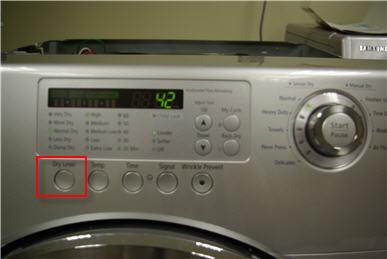What if the clothes are damp after a sensor dry cycle?
If clothes are damp at the end of a Sensor Dry Cycle, please check the following:
• Clothes that are damp at the end of a sensor dry cycle is usually caused by a lower dry level setting. To adjust the dry level, press the Dry Level Button for a higher setting. Heavier loads, such as jeans, require a higher dry level

• Avoid mixed loads. If you have a mixed load, such as jeans and t-shirts, the jeans will tend to stay towards the back of the drum, and the t-shirts will tend to stay in the front of the drum. Therefore, the sensor bars will detect that the t-shirts are dry and end the cycle.
• Check your Washing Machine. A Washing Machine that does not thoroughly dissipate excessive water will extend the drying time. Clothes that came out of the Washing Machine excessively wet will cause the dryer to operate inefficiently. A common cause is an over-loaded Washer.
• Large comforters may come out damp, or have wet spots. This can be a normal condition, depending on the size, and weight of the material of the comforter. Heavy / dense comforters do not tumble as a normal load of clothes would. It may be necessary to remove the comforter and reposition, and then add additional drying time.
• Add more clothes to the load. If there are only a few garments in the dryer on a sensor dry cycle, it will not work properly. Try adding a few more garments.
• If the Dryer is newly installed, the vent may be clogged. Samsung Dryers have a powerful exhaust blower motor. Residual lint in the vent pipe may become dislodged and collect in another area of the vent system, usually at elbows, bends, or the outside vent area.
Samsung recommends to replace the vent system with a new rigid vent system for proper operation of your Dryer.
If the suggestions above do not work, your Dryer will need service.
Thank you for your feedback!
Please answer all questions.
RC01_Static Content



